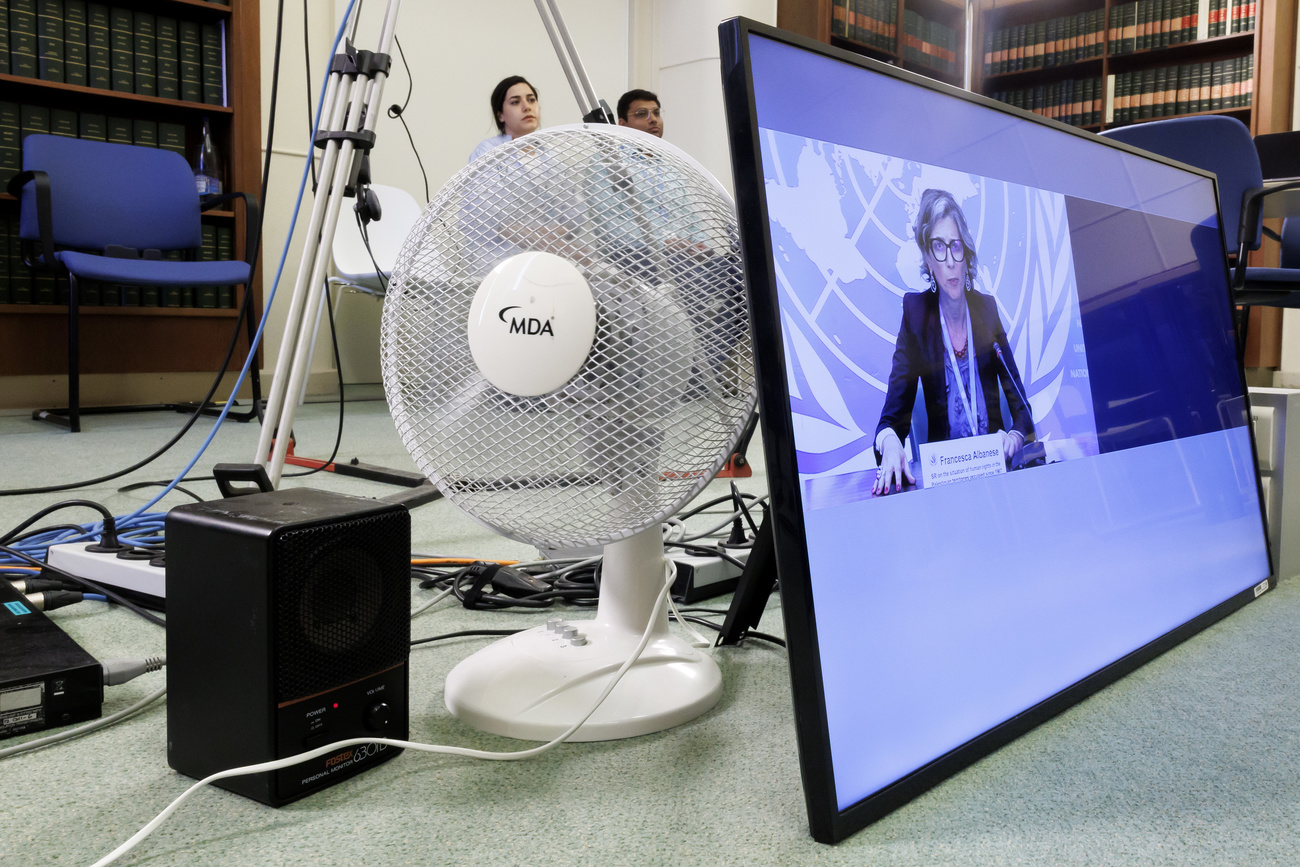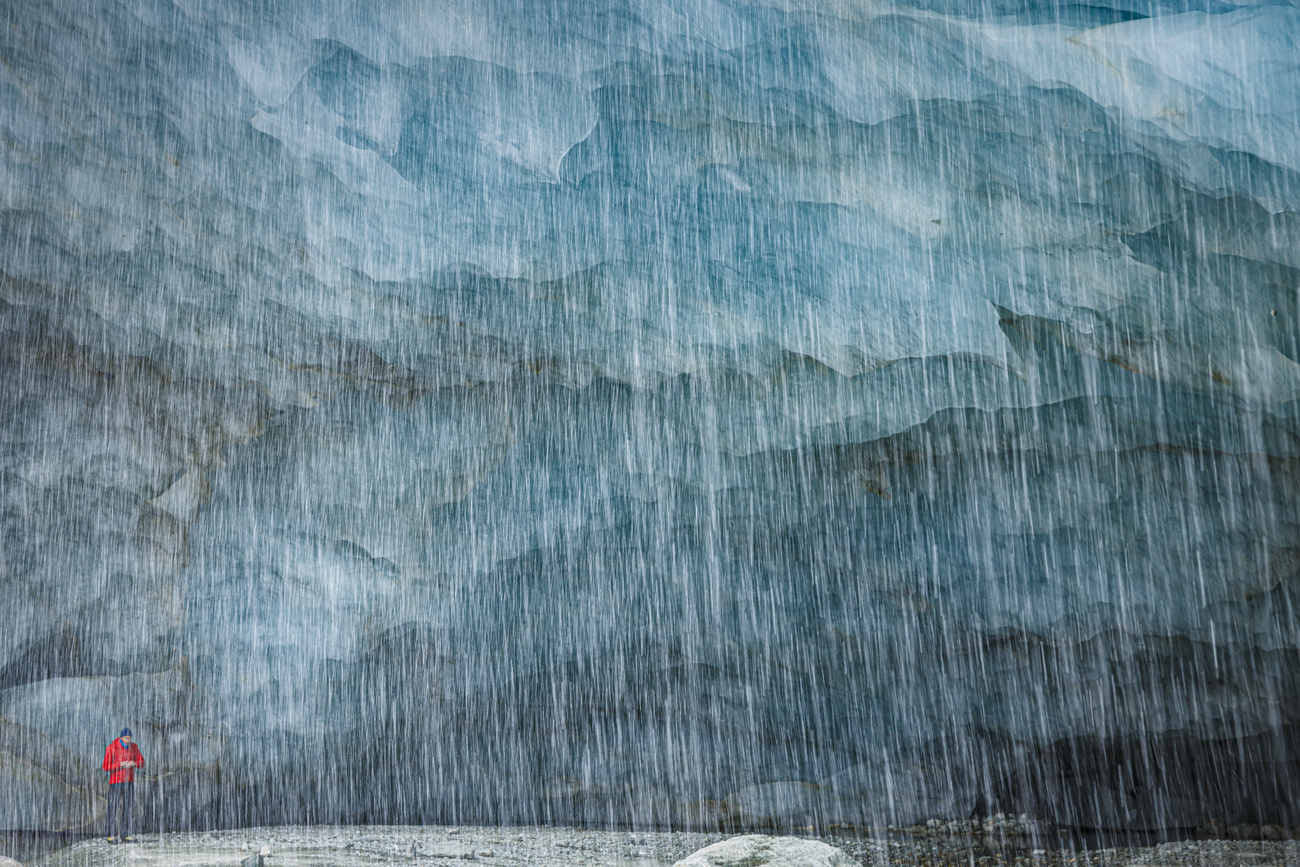Explainer: the World Meteorological Organization at the heart of the climate crisis

As climate change hits hard to set new records in global temperatures, the World Meteorological Organization is regularly cited in news reports. SWI swissinfo.ch looks at what this UN body does and why it matters.
Set between the United Nations (UN) headquarters and the seat of the World Trade Organization, the office building that is home to the World Meteorological Organization (WMO), will not be found on the most popular of Geneva tourist itineraries. But behind the abbreviation that has become increasingly commonplace in newswires is an organisation playing a central role in informing about the state of the climate and proposing practical solutions.
Appropriately garbed in embellished summer shirts, two WMO senior officers sweated it out on a particularly hot day mid-July– one of the hottest days this year in Switzerland with the temperature rising to 35°C – at a press conference called due to the extreme weather events caused by this year’s strong El Niño phenomenon. The occurrence of warm air over the Pacific named after the baby Jesus, had been predicted by the UN agency earlier this year, and data charts drew a worrying picture.
Michael Sparrow, chief of WMO’s world climate research programme, told journalists that the reporting of new records on all continents, including the highest ever average global temperature on July 7 at 17.24°C and extreme warming in the North Atlantic region, Western Central America and South America Pacific coastlines as well as sea ice melting around Antarctica, was not all that surprising.
“It’s not unexpected if you look at what scientists have been saying over the last twenty or thirty years. We would expect to keep crossing boundaries and keep hitting records for the warmest day,” he told journalists. “The scientific community has to catch up with what is happening in the Earth’s system. Things could be a lot worse than we predict.”
As the mother of all weather agencies and certainly one of the UN’s most scientific organisations, what the WMO reports and how it leads on global weather standards and efforts to address climate events and their impacts, matters increasingly. But like much of the UN system, it is not immune from politics.
What does the WMO do?
With climate change making extreme weather events all the more frequent, Petteri Taalas, at the helm of the WMO until January 2024, has pressed for stepping up weather observation systems, particularly in countries with historic gaps in reporting. The Early Warnings For All InitiativeExternal link, launched in 2022 and supported by UN Secretary General António Guterres, aims at boosting political, technological and financial action to ensure that populations are protected ahead of cyclones, flooding and other extreme weather events.
The WMO has been seeking more investment in the initiative. “By not putting early warning systems in place, we are not helping communities, societies and people to protect their lives, livelihoods and their ways of life,” Celeste Saulo, who will head the agency from January next year told SWI in one of her first media interviews since her nomination.
“So many people have to leave their homes after extreme weather events, such as storms, where they lose their access to food sources. It is difficult sometimes to understand how important the early warning systems are in terms of adaptation to climate change. We have to make sure that we have stronger meteorological services, to have stronger possibilities to build our societies and help them adapt.”
Meanwhile, the agency’s global observation networkExternal link, involving thousands of surface, air and sea stations, provides data that allows local forecasts to be formulated. The WMO also sets standards for weather observation and monitoring, allowing for a uniformity of practices and better accessibility of data and statistics, and coordinates meteorological research and training.
Human-made global warming was responsible for around 60% of Swiss heat deaths last summer.
Water has always flowed abundantly in Switzerland. Now, frequent droughts and high demand are increasing tensions and calls for regulation.
Switzerland makes predictions about avalanches, floods, and heat waves, but, unlike other countries, it doesn’t have a drought warning system – yet.
“Having the ability to share this information and introduce standards on how the information should be collected, gives us the possibility to understand why and how the climate is changing,” Saulo said.
She added that the organisation’s other attributes included its “constellation of satellite products” that help countries track weather systems, and the sharing of forecasts generated through WMO’s coordinated system of global meteorological centres, of critical use particularly in countries that may not have the ability to run their own forecasting models.
Who’s heading the organisation?
For the first time in its history which began in 1950, a woman will lead the organisation. Saulo, the director of the National Meteorological Service of Argentina and WMO’s first vice-president, was appointed as secretary-general, to replace Petteri Taalas of Finland, from the start of 2024, at the end of his second term in that role.
After facing off against three other candidates from within WMO – Russian-Swiss deputy secretary-general Elena Manaenkova, assistant secretary-general Zhang Wenjian from China and second vice-president Albert Martis of Curaçao – Saulo said she would bring “the voice of the less developed world, small island states, the developing world, working all together to achieve our priorities”, she told AFPExternal link following her election.
Saulo is also the latest woman to take the helm of a UN agency, just weeks after the election of Amy Pope at the International Organization for Migration. As a scientist, the Argentinian had conducted research into the South American monsoon system and weather issues related to agriculture and early warning systems.
In a phone interview from Buenos Aires, she said says that as secretary-general, she would support the agency to take a stronger position on highlighting its scientific knowledge regarding climate change. “I cannot separate policymaking from, say, the physics of the climate. [At the WMO ]we are based on technical information, that is an advantage. We are not building opinions. We are building statements from robust scientific information.”
What’s the link with the influential IPCC report?
Also housed at the WMO’s steely headquarters is the seat of the Intergovernmental Panel on Climate Change (IPCC), the leading scientific authority on climate change. It is responsible for publishing regular scientific assessment reports, based on thousands of peer-reviewed papers, on the impact of climate change on various natural environmental systems and human life.
The assessments, published in five-to-seven-year cycles of which the latest series was concluded this year, provide the basis for global, regional and national climate policy making, and represent key documents at annual climate summits, such as last year’s COP27 in Egypt.
Its specialised work groups also recommend actions to be taken for adapting to and mitigating climate change and where further research may be needed.

What can the WMO do to fight climate change?
In May, the WMO said there was a two-thirds chance that a rise of global temperatures by 1.5°C – which countries vowed to avert in the 2016 Paris Agreement – will be reached over the next five years, and a 98% possibility that at least one of those years will be the hottest on record.
According to the IPCC, with current climate policies, the world will reach a 2.7°C average temperature rise by the end of the century, way past any levels the Earth has ever experienced, and which scientists say would spell the end of life as we know it.
As much of the northern hemisphere sweltered under extreme heat warnings this month, Saulo said the record-breaking temperatures and their effects on public health provide opportunities to take action.
“Action is far from what member states have said they were going to achieve within UN climate talks,” she said. “They are not getting there and I don’t like what is happening. It’s really scary when you see maps of high temperatures all over the northern hemisphere, with extreme events beyond existing data.”
“While we see that the extreme weather is affecting the developed world, I hope that the decision makers living there will change their mind and accelerate action,” Saulo added. “But it is also about global corporations, some of which are even bigger than states in terms of power and their generation of carbon dioxide, methane and so on. It is time for them to react.”
Edited by Virginie Mangin

In compliance with the JTI standards
More: SWI swissinfo.ch certified by the Journalism Trust Initiative









You can find an overview of ongoing debates with our journalists here . Please join us!
If you want to start a conversation about a topic raised in this article or want to report factual errors, email us at english@swissinfo.ch.